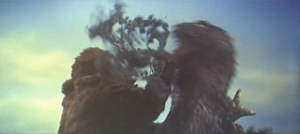
Submarines and sci-fi stories go together like fish and chips, as anyone who’s read 20,000 Leagues Under the Sea already knows. And if you thought that book hit it big in the English speaking world (I’m not even going to try and count how many times it’s been adapted to film) you should see the influence it had on Japan. Once Jules Verne hit the home islands his books sparked an SF craze that, in most respects, has never really gone away.
Local rip-offs were inevitable, the most important for us being Shunro Oshikawa’s Kaitei Gunkan (“Undersea Battleship”), published around 1900. The first in a series of what we’d now call “young adult adventure novels,” Undersea Battleship followed the crew of its titular device through a futuristic version of the Ruso-Japanese War that was, in reality, just around the corner. Like a lot of Japanese fiction at the time, it was enthusiastically imperialist, fiercely nationalistic, and (one would think) completely anathema to a post-war movie audience raised under the Constitution of 1945, with its explicit “wars are bad, m’kay” stance.
And yet…the popularity of Oshikawa’s books managed to survive both his death and the death of Japan’s imperial ambitions. Why wouldn’t it? They’re all about manly men doing manly things in service to manly causes. To a movie studio struggling to establish itself internationally as the age of James Bond dawned, that sounded like a recipe for success. And who better to bring all that to the silver screen than the people who brought you Godzilla, Rodan, Mothra, Varan and The Mysterians? That’ll make for a guaranteed-great movie…right? Continue reading Atragon (1963)






 On March 1, 1954, fallout from the United States’ Castle Bravo nuclear test on Bikini Atoll rained down on the 140-ton tuna boat
On March 1, 1954, fallout from the United States’ Castle Bravo nuclear test on Bikini Atoll rained down on the 140-ton tuna boat